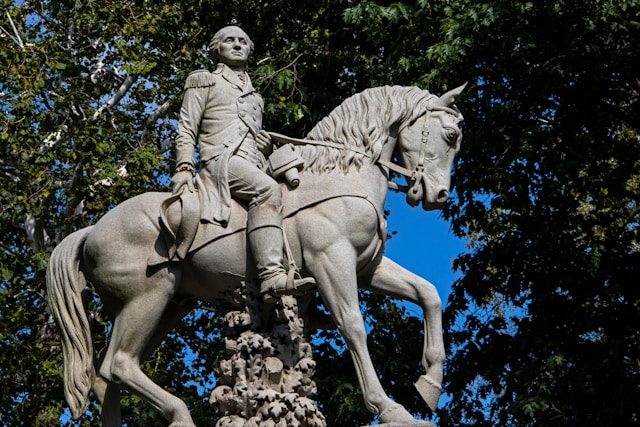
The French and Indian War (1754–1763) was a pivotal conflict in North American history, part of the global struggle between the British and French empires known as the Seven Years’ War. While the Treaty of Paris (1763) officially ended the war and granted Britain control over much of North America, it is essential to recognize the individuals—both famous and forgotten—who shaped the conflict. Below is a closer look at key figures and unsung heroes who played vital roles in this war.
George Washington: A Future American Icon in the Making
George Washington’s early career began during the French and Indian War. At just 22 years old, Washington led an expedition to Fort Duquesne (in modern-day Pittsburgh), where he encountered French troops at Jumonville Glen. This skirmish triggered the broader conflict.
Despite setbacks, including the surrender at Fort Necessity, Washington gained critical military experience. His leadership during General Edward Braddock’s failed campaign to capture Fort Duquesne in 1755, where Washington helped organize the retreat, showcased his resilience. The lessons he learned during the war would prove invaluable during the American Revolution.
General Edward Braddock: A Tragic British Commander
General Edward Braddock was a seasoned British officer tasked with driving the French out of the Ohio Valley. Unfortunately, his traditional European battlefield tactics were ill-suited to North American wilderness warfare. In 1755, Braddock led a force toward Fort Duquesne, but they were ambushed by French troops and their Native American allies near the Monongahela River.
Braddock was mortally wounded, and his army suffered devastating losses. Despite the failure of the campaign, Braddock’s defeat highlighted the need to adapt military strategies to new environments, influencing future military campaigns in North America.
Marquis de Montcalm: The French Commander with Limited Support
Louis-Joseph de Montcalm commanded French forces during the critical years of the war. He achieved several impressive victories, including the capture of Fort Oswego in 1756 and the defeat of British troops at Fort William Henry in 1757. His greatest triumph came in 1758 when he successfully defended Fort Carillon (later known as Fort Ticonderoga) against a much larger British force.
However, Montcalm’s efforts were undermined by a lack of reinforcements and growing tensions between French officials and Native allies. His most significant defeat came at the Battle of Quebec in 1759, where he lost his life. Despite his skill, Montcalm remains a lesser-known figure compared to his British counterparts.
General James Wolfe: The Victor at Quebec
James Wolfe was a rising British star who led the campaign to capture Quebec, the capital of New France. In 1759, Wolfe launched a daring assault on the cliffs leading to the Plains of Abraham, surprising the French defenders. The battle was a turning point in the war, securing British control over Canada. Although Wolfe perished in the fight, his victory at Quebec is remembered as one of Britain’s most outstanding military achievements. His strategic genius ensured that British interests would dominate North America for years to come.
Pontiac: The Native Leader Who Resisted British Control
While the Treaty of Paris ended the war between European powers, Indigenous resistance persisted. Pontiac, an Odawa chief, led a coalition of tribes against British expansion in the Great Lakes region after the war. Known as Pontiac’s Rebellion (1763–1766), the uprising reflected Indigenous anger over the loss of autonomy and British policies that restricted trade and settlement.
Forgotten Heroes: Native Allies and Militiamen
Indigenous warriors from tribes such as the Huron, Algonquin, and Shawnee sided with the French, while others, like the Iroquois Confederacy, allied with the British. These alliances were crucial to both sides, influencing the war’s outcome through guerrilla tactics and ambushes.
Colonial militiamen, though untrained compared to regular British troops, provided essential support during crucial battles. Their knowledge of the terrain and experience in frontier warfare were invaluable in campaigns across the Ohio Valley and New York. These unsung heroes often fought without the recognition or rewards given to professional soldiers.
The Role of Civilians and Women in the War
Civilians also played a crucial role during the French and Indian War. Women managed farms, businesses, and households while men were away fighting. Some women even accompanied military camps, serving as cooks, nurses, and laundresses. Their work, though largely unrecognized, was vital to maintaining morale and ensuring the smooth operation of military campaigns. Additionally, local communities provided food, supplies, and shelter to armies passing through their regions, often at significant personal cost. Civilians on both sides experienced the brutal realities of war, including displacement and attacks on settlements.
Legacy of the French and Indian War
The French and Indian War reshaped the geopolitical landscape of North America. Britain’s victory laid the groundwork for the American Revolution by fostering resentment among colonists who were frustrated by new taxes imposed to pay off war debts. Furthermore, the conflict altered relationships with Indigenous peoples, leading to further struggles over land and sovereignty.
The French and Indian War was a complex conflict involving diverse participants with varying motives and experiences. While figures like George Washington and James Wolfe are celebrated in history books, many others—such as Robert Rogers, Pontiac, and countless Indigenous warriors—remain in the shadows. By acknowledging both the famous and the forgotten, we gain a fuller understanding of this critical period and the people who shaped it. Their stories remind us that history is not just about generals and battles but also about the everyday sacrifices made by ordinary individuals.